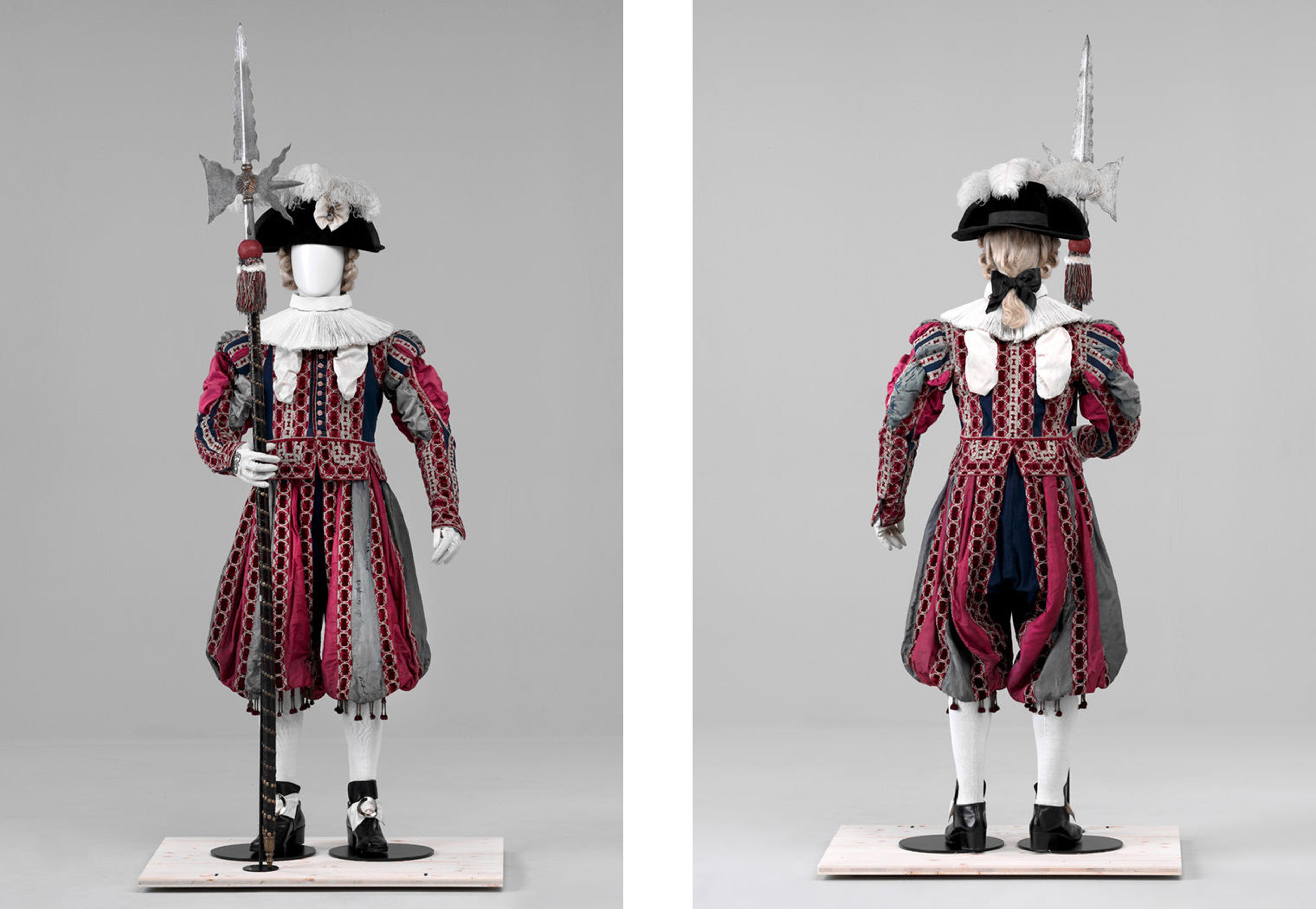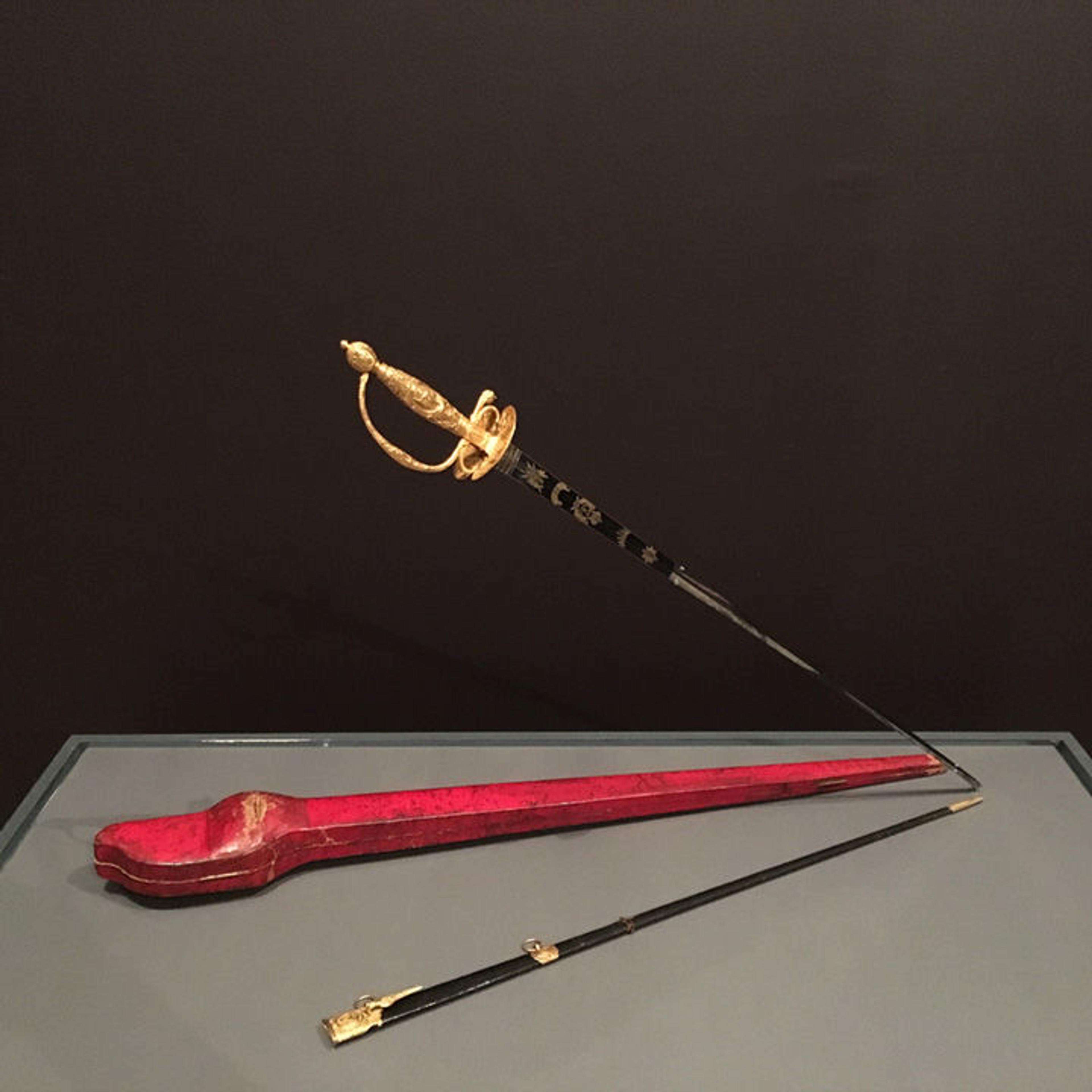Decorated Swords and the Artistry of Arms at Versailles

Ceremonial uniform of the Cent-Suisses, 18th century. Silk and velvet (uniform), gold-plated iron (halberd), linen and flax (collar), leather and gold embroidery (gloves); halberd: 93 5/16 x 11 5/8 x 4 3/4 in. (237 x 29.5 x 12 cm); length (of jacket sleeve): 27 9/16 in. (70 cm); length at CB (of jacket): 23 5/8 in. (60 cm); width (of jacket waist): 35 7/16 in. (90 cm); length (of trousers): 39 3/8 in. (100 cm); width (of trouser waist): 33 7/16 in. (85 cm). Swiss National Museum, Zurich (LM-16618.1-.2 [uniform], LM 70591 [halberd], LM 450-c [collar], AG–2419 [gloves], AD–2248 [wig]). Photo: Swiss National Museum, 41912
While swords and other arms might seem, at first, unrelated to the pageantry and pomp of the Bourbon Court at Versailles, they would have appeared ubiquitous to visitors. Gentlemen carried elaborately decorated swords as a matter of daily dress, and the palace guard would have been armed as well, usually with ceremonial weapons intended to reflect the wealth and power of the State. Ornate objects such as these, whether military, civil, or intended for the court and hunt, would have been an integral part of a visitor's experience of Versailles.
When exhibition planning first began for Visitors to Versailles (1682–1789), the Department of Arms and Armor was asked to select a group of objects that would contribute to the greater narrative of the exhibition: "What it was like to be at Versailles during the ancien régime." We selected four smallswords and three staff weapons from The Met collection, which together illustrate the splendor of the court at Versailles.

Left: Smallsword (detail), ca. 1750. French. Steel, silver, gold, wood, textile; 37 3/4 x 4 x 3 in. (95.8 x 10.2 x 7.6 cm); blade: 30 7/8 in. (74.8 cm). The Metropolitan Museum of Art, New York, Gift of Jean Jacques Reubell, in memory of his mother, Julia C. Coster, and of his wife, Adeline E. Post, both of New York City, 1926 (26.145.283)

Left: Smallsword (detail), 1780. French. Steel, gold, wood, textile; 35 1/4 x 3 1/2 x 2 3/4 in. (89.5 x 8.9 x 7 cm); blade: 29 7/16 in. (74.8 cm). The Metropolitan Museum of Art, New York, Gift of Jean Jacques Reubell, in memory of his mother, Julia C. Coster, and of his wife, Adeline E. Post, both of New York City, 1926 (34.57.11)

Left: C. Liger (French, recorded 1770–93). Smallsword with scabbard (detail), ca. 1780. French. Steel, silver, gold, wood, textile, fishskin; 38 5/8 x 4 1/2 x 3 1/4 in. (98.1 x 11.4 8.3 cm); blade: 31 1/2 in. (80 cm). The Metropolitan Museum of Art, New York, Gift of Jean Jacques Reubell, in memory of his mother, Julia C. Coster, and of his wife, Adeline E. Post, both of New York City, 1926 (26.145.291a, b)

Left: Guilmin (French, recorded 1767–75). Smallsword carried by the Gardes du Corps (detail), 1769. French, Versailles. Steel, silver, wood, textile; 39 5/16 x 4 1/2 x 3 1/2 in. (99.8 x 11.4 x 8.9 cm); blade: 32 1/8 in. (81.6 cm). The Metropolitan Museum of Art, New York, Gift of Jean Jacques Reubell, in memory of his mother, Julia C. Coster, and of his wife, Adeline E. Post, both of New York City, 1926 (26.145.317)
The inclusion of these objects also serves as a good example of the collaborative nature of special exhibitions. As the armorer and conservator in the Department of Arms and Armor, my role when working on an exhibition is chiefly concerned with the conservation and physical preparations needed to ready our department's objects for exhibition. Alongside curatorial and collections-management staff, Assistant Conservator Sean Belair and I share the primary responsibility of conserving and making mounts for the Museum's large collection of armor, weapons, and related accoutrements.

Left: Partisan carried by the bodyguard of Louis XIV (1638–1715, reigned from 1643) (detail), ca. 1658–1715. French, Paris. Steel, gold, wood, textile, brass; 94 3/8 in. (239.7 cm); head: 20 3/4 x 5 7/8 in. (52.7 x 15 cm). The Metropolitan Museum of Art, New York, Purchase, Rogers Fund, 1904 (04.3.64). Center: Inscription probably refers to Bonaventure Ravoisie (French, recorded 1678–1709). Partisan carried by the bodyguard of Louis XIV (1638–1715, reigned from 1643) (detail), ca. 1678–1709. French, Paris. Steel, gold, wood, textile, brass; 94 1/8 in. (239 cm); head: 22 9/16 x 6 1/2 in. (57.3 x 16.5 cm). The Metropolitan Museum of Art, New York, Purchase, Rogers Fund, 1904 (04.3.65). Right: Jean Berain (French, 1640–1711). Partisan carried by the bodyguard of Louis XIV (1638–1715, reigned from 1643) (detail), ca. 1679. French, Paris. Steel, gold, wood, textile; 86 11/16 in. (220.2 cm); head: 20 9/16 x 6 1/16 in. (52.2 x 15.4 cm). The Metropolitan Museum of Art, New York, Gift of William H. Riggs, 1913 (14.25.454)
The Museum's collection of over fourteen thousand arms and armor objects is often interpreted through projects like these, which give the department an opportunity to assess and examine objects in new contexts. Visitors to Versailles includes the Museum's rare example of a smallsword carried by a member of the Gardes du Corps, the aristocratic guards of the royal household. The delicate silver hilt required careful conservation to ready it for photography and display, as did the other smallswords drawn from the Museum's collection. The swords and staff weapons belonging to The Met (above) also required newly fabricated mounts to incorporate them into the display.

Hilt by an unidentified goldsmith, mounted by the workshop of Veuve Guilmino, Versailles. Presentation sword, 1780. French, Versailles. Sword: partly blued steel, gold hilt; scabbard: black-painted leather and gold; case: wood covered with morocco leather with gold tooling and lined with chamois; brass; sword: 39 3/4 in. (101 cm); scabbard: 33 in. (83.8 cm); carrying case: 3 1/2 x 4 1/2 x 41 in. (8.9 x 11.4 x 104.1 cm). US Naval Academy Museum.
Image courtesy the US Naval Academy Museum
One object on loan from the US Naval Academy—a sword given by the king of France to Captain John Paul Jones—also required a new mount. Mounts of this type are something that I especially enjoy creating, and, in this case, the privilege of working with a sword belonging to Captain Jones was a particular treat. This unique piece of American history, mounted in the workshop of the goldsmith Veuve Guilmino, is a magnificent, gold-hilted presentation sword.

Charles Ernest Pont (American, 1898–1971). Defeat of the Serapis (detail), 1929–34. Published by PWAP. Lithograph; image: 8 3/4 x 12 in. (22.2 x 30.5 cm); sheet: 11 1/4 x 15 3/4 in. (28.6 x 40 cm). The Metropolitan Museum of Art, New York, Loan, Lent by the United States Government, Public Works of Art Project, New York Regional Committee, 1934 (34.104.9)
Given as a gift to Jones by King Louis XVI, in 1780, the sword commemorates what is perhaps Captain Jones's most famous naval encounter in the American Revolution. In command of the forty-two-gun frigate Bonhomme Richard, Jones engaged the British fifty-gun frigate Serapis off the coast of the British Isles. Early in the fight, the British captain called for Jones to surrender. His response: "Sir, I have not yet begun to fight!" After a bloody three-and-a-half-hour battle, Jones was victorious. It was due to decisive actions such as this that Jones earned the sobriquet "Father of the American Navy," and this gold sword was a fitting recognition by a king who had long been a fellow adversary of Great Britain.

Fabricating steel mounts for wall-mounted staff weapons. Photo by the author

John Paul Jones's presentation sword, as displayed in Visitors to Versailles. Photo by the author
Today, the sword is wonderfully well preserved, and we displayed it at a dramatic angle to highlight the detail and artistry of the gold hilt. To execute the raking angle, I used steel for the mounts—as we do for almost all arms and armor objects. Though difficult and time-consuming to fabricate, custom steel mounts allow us to achieve displays that accentuate and highlight the best and most notable features of each object. With an exhibition like Visitors to Versailles, which is already a wealth of magnificence, adding examples of the swordmaker's art enriches the entire experience by showcasing the depth and scale of the opulence.
Careful conservation and the fabrication of object mounts is a critical part of the planning and installation of any exhibition. The nature of the Arms and Armor collection, which spans many cultures and histories, means that there is often an intersection between our department's objects and other areas within the Museum. Such intersections can be as personally rewarding as they are illuminating to the visitor—they give opportunities to share our passion and see our work in the galleries, through the creation of an experience that inspires and connects people in exciting and unexpected ways.
Related Content
Visitors to Versailles (1682–1789) is on view at The Met Fifth Avenue through July 29, 2018.
Learn more about the binaural audio experience and view the exhibition galleries.
Learn more about Visitors to Versailles in a blog series published in conjunction with the exhibition.
The exhibition catalogue is available for purchase at The Met Store.
Edward Hunter
Edward Hunter is responsible for the care and preservation of the department’s collection. As supervisor for the Armor Lab, his primary duty is the treatment and conservation of all types of objects, including armor, firearms, and edged weapons, as well as fabricating custom mounts for displays. Edward enjoys working with the education and digital departments on various projects. He received his BA in art history from the University of Nebraska-Lincoln and an MSc in conservation from the University College London’s Institute of Archaeology. Examples of his work include a close-helmet, a Colt Model 1862 police revolver, and the armor of Henry II, King of France.
Selected publications
#MetKids: “#MetKids—How Does the Museum Take Care of All the Armor?”
Hunter, Edward A. “A Technical Examination of the Lion Helmet.” In Metropolitan Museum Studies in Art, Science, and Technology 2 (2014): 189–196.